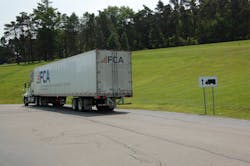Insurance experts: Technology can cut a fleet's risk profile
In the world of trucking insurance, technology – from electronic logging devices (ELDs) to speed monitoring and in-cab video camera systems – is playing a bigger and bigger role in the risk analysis process; to the point where it may begin to affect how carrier premiums are calculated, especially in light of the new safety scoring system established by the Comprehensive Safety Accountability (CSA) program.
“It is definitely becoming easier to assess and measure risk [as] information is becoming more available to motor carriers, and motor carriers are more aware of how they compare to their peers in respect to safety,” Josh Thompson, senior broker with the trucking practice within Aon Risk Solutions, told Fleet Owner.
He added that CSA has been a key component in making that happen and has created a big push in the trucking industry for truckers to become more accountable for risk management.
“Insurance carriers as well as shippers are cognizant of motor carrier's CSA scores and are considering them when deciding who to do business with,” Thompson explained. “We are seeing trucking firms make investments in their risk management program to manage CSA scores, which in turn is creating safer fleets.”
He noted that Aon takes a “holistic approach” to analyzing trucking risks, looking at a variety of factors including: the motor carrier’s safety manual, its training program, driver hiring requirements, broker hiring and cargo management procedures.
Yet especially when it comes to analyzing motor carrier safety practices, Thompson believes technology is poised to play a greater role. “Technology will have a significant impact on managing trucking risk and insurance,” he said. “One example of that are electronic logs; we are seeing electronic logs have a positive impact on hours of service (HOS) compliance.”
Along that line, Rick Ochsendorf, senior VP of operations at PeopleNet, noted that his company is witnessing almost a doubling of data requests from insurance companies over the last two years – especially where CSA-focused metrics are concerned.
“This is driven, in part, by our customers who implement technology solutions to better understand the correlation between technology, safety and ROI [return on investment],” he explained to Fleet Owner. “For example: by leveraging new safety tools, such as speed monitoring, trucking companies can improve their CSA scores.”
With permission from its carrier clients, PeopleNet can provide data to insurance companies that clearly illustrate how well a carrier performs on the road by exceeding standards of safety and efficiency, Ochsendorf noted.
“Our customers have found that by providing telematics data to insurers, the company can mitigate insurance risk and thereby help reduce insurance rates,” he said.
In Ochsendorf’s view, some key examples of technology available today that can help trucking clients utilize telematics data to mitigate insurance risks include:
- Tracking HOS – By integrating tracking into the back office, dispatch can track driving hours more efficiently, load plan more effectively, and haul more freight when available.
- Speed monitoring – By having this software both in the cab and the back office, drivers and driver managers both can receive alerts to manage their speed with safety and efficiency in mind.
- Cameras and sensors – Most accidents occur when a truck is backing up or someone/something has moved into their blind spots. By utilizing cameras and sensors, drivers can reduce or eliminate blind spots and backing up accidents altogether.
- Real-time tracking of equipment longevity and fault codes – By having alerts and diagnostics to warn a driver when there is something wrong with the vehicle, the driver and/or maintenance manager can address any issues before it becomes a safety risk. Drivers have less of an opportunity to get into an accident if their vehicle is properly maintained. Equipment tracking includes proper tire pressure, fault code monitoring, and more.
- Cargo damage and cargo theft – Door sensors can alert drivers if trailer doors are open or shut, when the temperature in a refrigerated truck gets too high, and more, thus preventing theft or damage to cargo. If damage should occur, drivers can use their tablets to take pictures of damaged cargo and relay the message back to the office in real-time.
“All of the aforementioned technology solutions produce data that can be used to create confidence in a fleet and prove a solid track-record of safety, with less accidents or damage,” Ochsendorf stressed. “By harnessing the built-in safety tools, integrated logs, speed gauges and monitoring, insurance claims can drop significantly.”
As for the future of trucking insurance mitigation, PeopleNet believes the industry will lean toward the idea of an “Internet of Transportation Things” and predicts it will be a critical component of the success of a fleet within the next five to 10 years.
“We have already begun to see this technological shift; our current technology solutions are already inter-connected with one another and future products/offerings will be designed with this in mind,” Ochsendorf pointed out. “Drivers will soon find themselves in a world where their wearable devices, mobile phones, truck sensors and on-board cameras can help coach them into healthy habits and responsible driving practices, thereby increasing safety measures and reducing dangerous situations.”
About the Author
Sean Kilcarr
Editor in Chief
Sean Kilcarr is a former longtime FleetOwner senior editor who wrote for the publication from 2000 to 2018. He served as editor-in-chief from 2017 to 2018.
